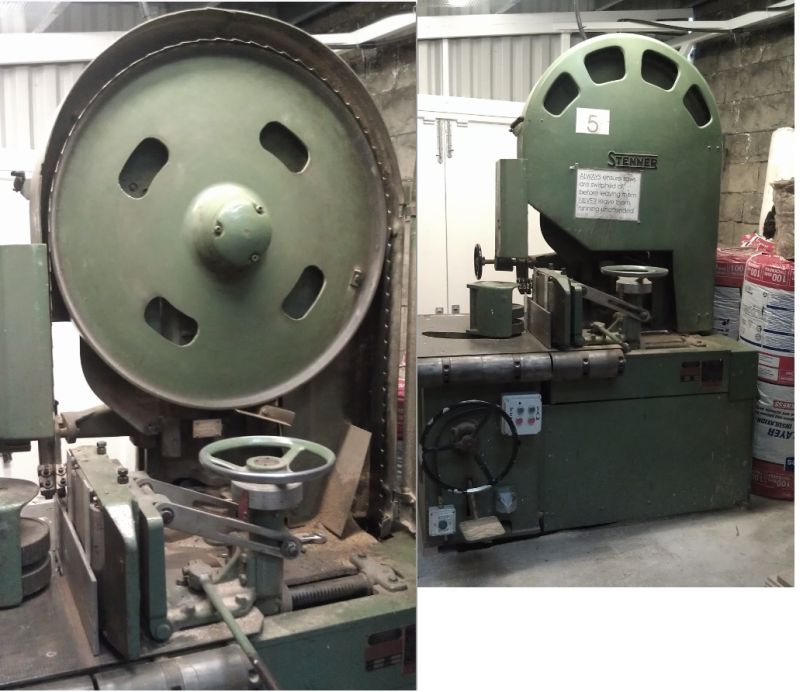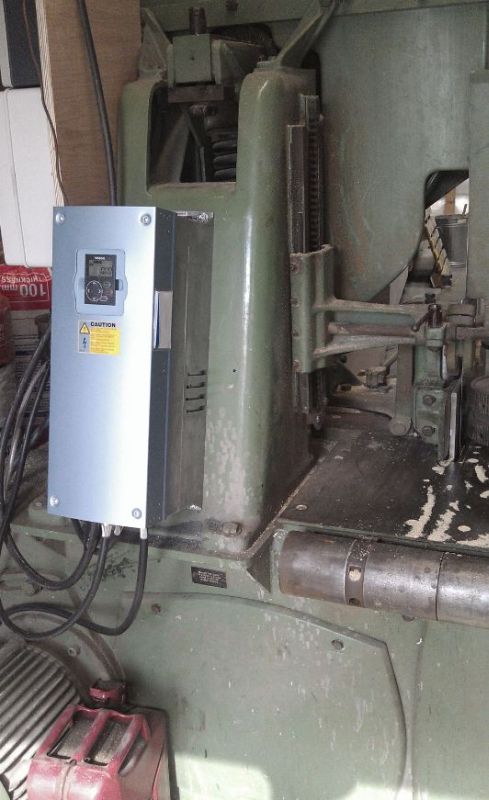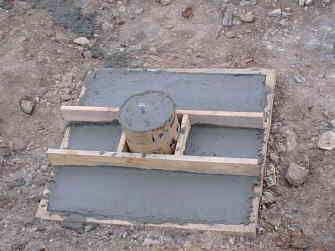Power Saving Effect of an Inverter on a Resaw
Here's an interesting discussion of the power savings you can get by using an inverter to start a large electric motor, and of the possible complications involved in doing so. November 5, 2013
Question (WOODWEB Member) :
I'm going to talk about the power saving effect I experienced when I replaced a Star-Delta starter with an inverter on my resaw (pictured below). The first video below shows an ameter reading the input current of an old resaw starting up using a start delta starter. The motor in the video is driving two 36 inch heavy steel wheels (one of which is pictured below) so there is a lot of inertia. You can hear the motor speed up from stand still to mains 50hz speed. It takes about 20 seconds for the motor to reach 50hz. As expected the current starts off very high, about 44amps, and gradually reduces as the motor speeds up. Near the end you can see the current jump up as the starter switches to delta. The coasting no load current is about 11.9 Amps as can be seen at the end of the video.
I replaced the Star-Delta starter with an inverter and measured the inverter input current as can be seen in my second video. On machine start up from stand still in the video, the current can be seen to gradually increase to around 13 Amps over 20 seconds until 50Hz is reached and then the current drops to around 4.5 Amps at coasting no load.
As I expected the inverter has greatly improved the power needed to start the resaw. What I didnít expect was the inverter to reduce the no load coasting current so much - from 11.9A to around 4.5A. The inverter obviously does something clever to achieve this. The other useful feature of an inverter is that it can be used as brake which is actually the primary reason why I installed it. In the UK we have to bring a band saw type machine to a stop within 30 seconds. I have set my inverter to stop the resaw within 18 seconds. I hope some of you found this useful.

Click here for higher quality, full size image
If you are seeing this message, your version of flash needs to be upgraded to view this video.
Click here to get the latest version of the Flash player. |
Forum Responses
(Solid Wood Machining Forum)
From Contributor P:
That is very interesting to me as I was recently thinking of buying a Forestor 900 resaw but put off a bit by the lack of soft start on that model. As best I can tell the Forestor doesn't even have a Star-Delta arrangement (like my SCMI/Centario R800 resaw does).
Both Forestor 900 and SCMI R800 are 20 hp. What hp motor is your saw? Assuming one is not concerned with braking, what do you think about adding an electronic soft start versus a VFD? (Both rated for 20 hp of course). I only ask as the soft start is less expensive. I'm in USA but there are a surprising number of Forestor 900's (made in UK) floating around for sale. They appear a bit more impressive than the SCMI R800 but I've heard that lacking soft start there are even problems with the belts slipping on start up.
From the original questioner:
The motor on my resaw is rated at 20HP. If my resaw was direct online then the initial current drawn would be over 80 amp which is not viable at all. I did have a DC brake on my resaw before I fitted the inverter. This DC brake had a so called soft start which was nothing like the soft start you get with an inverter. This soft start still drew 55Amps on startup which was even more than its original Star-Delta starter. So I'm not impressed with these basic bridge rectifier type soft starts. This DC brake/soft start developed a fault so I had to rewire the original start delta starter which was better for starting anyway.
I looked at getting another DC brake with soft start which was going to cost around around 600 but for 1300 I could have an inverter with all its benefits. I was wiring up myself so I thought if I was going to do it I was going to do it the best way. You are probably going to be better off with a Star-Delta starter for the purpose of your resaw as it uses less current and they last forever. Also, with these soft starts, they still connect the motor up directly to the mains in delta after its initial startup time just like the Star-Delta starter does. An inverter VFD has so many benefits over a basic soft start:
1. They use very little power to start up something with a lot of inertia like a resaw.
2. As the initial startup current is low, it doesn't cause a dip in the mains voltage which might affect other devices in your workshop. I know my lights used to dim when I turned my resaw on with the Star-Delta starter.
3. It is far more efficient when it isn't under rated load and most of the time it isn't. You can see this from my videos. Even when the resaw is under rated load inverters are supposed to improve efficiency by around 10%.
4. The dynamic braking from an inverter is far better than DC braking.
5. You can stop and start an inverter as many times as you want and it wonít trip anything even while itís starting up.
Belts slipping? I've never had this problem with my Stenner resaw. I don't ever recall replacing the belts. With an inverter you can extend the start time to whatever you like (from 0.1 second up to several hours if you like). So, an inverter would certainly help stop any belt slip on start up. The soft start in your listing only gives a maximum start up time of 20 seconds. This is not long enough in my opinion if belt slip is a problem.
From Contributor P:
Perhaps I should pursue a 20 hp VFD then. Regarding belt slippage, I was referring only to the Forestor 900. As an aside itís interesting about the number of resaws made in the UK. The Wadkin EEC looks impressive in photos for example, but I have never seen one for sale over here. Any thoughts on the EEC?
From the original questioner:
Well, if you are considering an inverter the only problem is that the installation of one is far more complex than a simple soft start or Star-Delta starter so not all electricians will be comfortable with it. I'm not necessarily recommending using an inverter as it might turn into a bit of a battle with electricians and become more trouble than itís worth. If you do want to go down the inverter route then I used a vacon inverter NXL model as pictured below.
I'm not a fan of resaws with the bottom wheel not in a pit. My bottom wheel is in a pit which enables the bed height to be much lower (less lifting). The bed height on my Stenner is only 810mm whereas the EEC bed height is 900mm and it only has 800mm wheels whereas my wheels are 915mm. Wadkin machines were the best before they went bust and were built to last forever so I expect the EEC to be very good, although I've never seen one. My Stenner resaw is over 35 years old and still going strong. Stenner as a UK company is still operating.

Click here for higher quality, full size image
From Contributor P:
The Wadkin EEC sales brochure mentions it was built (or designed) in conjunction with Robinsons. Is Robinsons still in business? Good point about the advantages of the lower wheel being in a pit. Regarding wiring a VFD, I often repair CNC machines at the component level so no problem figuring it out but I do have a problem with anything like that if itís consuming or tedious. Any estimate on the time you spent on the VFD conversion?
From the original questioner:
Very interesting, the EEC was made with Robinson, I didn't know that. I have seen a Robinson resaw and they look very similar in construction to my Stenner. I don't know if they are still in business. Installation time: I did it on and off over a period of about a week. I probably spent around two days on it in total. I fitted remote on/off switches that triggered relay latches and contactors with overloads to automatically turn on and off power to the extraction, power feed and oil via a solenoid valve. I did more than I should have done really.
If you want to do as little as possible you could in theory just use the keypad to turn the inverter on and off instead of using remote momentary switches which need relay latches. Or install a simple rotary switch. It takes time to read and understand the manuals. The support for vacon inverters is very good in the UK.
From the original questioner:
I would just like to add that I'm in the UK and we run on 415V three phase instead of 230V as in the USA. Your motors must require a lot more current than ours to achieve the same power rating. The rated current on my 20HP motor is 30A so I'm guessing to achieve the same power on your lower voltage supply you will need a rated current of around 50 to 60 Amps. Am I right? I'm also guessing that the current readings in my videos will be misleading for people in the USA as well. If you multiply the readings in my videos by a factor of 1.8(415/230) I think this should give the equivalent USA current. Being as though the USA works with much higher currents I would think an inverter would probably benefit people in the USA more than what it does me in the UK.
From Contributor P:
Yes, I'm aware of your curious 415 volts as I once owned a Harrison CNC lathe at that voltage. I say curious, not because of what we use here but because most of Europe was on 380 volts until recently, but now at 400 volts. So I wonder why the UK chose a voltage that apparently no one but the UK uses? Here, most small shops use 240 volts and a few use 208 volts. A majority of larger shops use 480 volts (what I have, but use transformers for 240 volt machines sometimes). A few shops here use 575 volts! The 575 is a holdover from water power days when water turbines provided 575 for the textile mills.
From Contributor P:
I forgot to mention that most of the Forestor resaws I've run across for sale here are set up for 480 volts. My SCMI R800 can be arranged for either 240 or 480 volts.
From Contributor P:
You probably know this already, but for those that don't, at the end of the day your actual power usage that you get billed for by the electric company is exactly the same whether you use 240 volts or 480 volts. It's all about saving copper and using smaller circuit breakers, not saving electricity. You can use 1/2 the wire size for 480 volt motors compared to same HP 240 volt motor.
From the original questioner:
I've had a Stenner engineer out to look at my resaw. Apparently they still use Star-Delta starters to power their resaws. I would have thought that all new modern high inertia machines would use inverters with all their benefits. On the braking side I have managed to get the inverter to brake the resaw to a stop within nine seconds. I'm quite astounded at this. It dynamically brakes from 50hz to 1.5hz and then uses dc braking from 1.5hz to 0hz. Dynamic braking doesnít bring it to a dead stop and needs dc braking for that last little bit. So, an inverter is even very efficient when braking.
From Contributor P:
"I've had a Stenner engineer out to look at my resaw. Apparently they still use Star-Delta starters to power their resaws."
I guess they figure the old way is good enough and perhaps they are afraid some customers may worry about those new fangled electronics that they can't fix themselves.
From the original questioner:
Yes, I agree it would be far easier to get an electrician to fix a start delta starter than an inverter. If an inverter went into fault mode there could be a possibility of the machine being out of action for a long time, maybe weeks. If a start delta starter went faulty it could be repaired within a couple of hours. We've been using inverters now for about two years and they have proved extremely reliable but whether they will be working in the next 10 or 20 years, like a start delta starter would, we will have to see.
If reliability is a concern you could fit an inverter and a Star-Delta starter and switch between them if one went faulty. I haven't done this on my resaw but I have done the same thing on my DC control. The interesting thing that I've found with inverters is that they do exactly what it says on the tin. All the claims about power savings are true.


